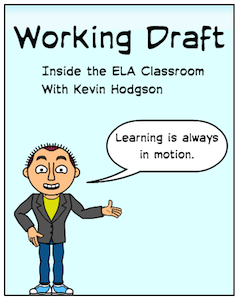Avoiding the Reefs as We Navigate Testing Season
A MiddleWeb Blog
 Like many educators, I find myself continuing to grapple with changes on the educational landscape.
Like many educators, I find myself continuing to grapple with changes on the educational landscape.
This month, with our state’s standardized testing season approaching, I have been working overtime, it seems, to determine just what will be on our revised English Language Arts assessment for my sixth graders, and how best to prepare them for it.
And all without turning my classroom into “test prep central,” which I refuse to do.
Still, they have to be ready
They have to know what to expect when the two days of testing arrives, and the more I have done my own research, the more I realize just how complex our state is making the tests for our students.
We’ve had our state testing system for many years, and the focus for sixth grade has long been on reading skills. A little background: Massachusetts has opted out of the PARCC test, for now, and is developing its own “next generation” Massachusetts Comprehensive Assessment System (MCAS), known also as MCAS 2.0 (we had another one during the NCLB era). There seems to be a fair share of overlap between PARCC and our state test as it now stands.

The practice tests I have been doing with my sixth grade students makes clear the emphasis that the state has put on what students should be able to take on as independent readers and writers at this age, where critical thinking skills are still developing.
There are two main PARCC-influenced critical thinking components now fully embedded into MCAS: the Narrative Writing Task and the Literary Analysis Task. Some reflections:
Preparing for the Narrative Writing Task
The Narrative Writing Task is actually an intriguing one. Students are given a reading passage – often excerpted from a novel or a short story – and they must write a new narrative story, following whatever the prompt might be.
I’m actually happy to see narrative writing as a component, since the Common Core standards and emphasis seemed to neglect narrative texts in favor of non-fiction texts. All indications for sixth graders are that they must use characters and setting from the story provided in the story they will write. Fifth grade seems to focus on point of view. Unlike the past MCAS, mechanics and grammar are counted on the rubric, which awards up to four points for story-writing and three points for grammar and mechanics.
Here’s how I have approached the MCAS “read this, write this” narrative concept over the past three months:
✻ We did a “cold read, cold write” where I presented them with a story and simple directions – “write the next part of the story.” This gave me some initial student work to examine and to realize that story length was going to an issue. Most only wrote a single paragraph and few paid attention to mechanics.
✻ I did some mini-lessons on story writing, reviewing what we had worked on earlier in the year, particularly around proofreading and formatting. Too many of my students write stories in one massive paragraph, jamming all of the text together. They need constant reminders to format paragraphs and dialogue to make the reading experience easier on the reader.
✻ They read a story, and wrote, and then anonymously “assessed” another student’s writing, giving them a view from the teacher (and scorer) chair. They reflected on the experience of using the state rubric, which is not very specific, to be frank.
✻ They practiced by writing more stories, paying attention to character, setting, extended text and proofreading as much as possible, with no access to a dictionary.
Understanding the Literacy Analysis Task

I’ve had to take this a bit slower as I introduce the concept and be much more deliberate in how we can use graphic organizers, highlighters, coding marks within the text, and essay writing techniques. I’ve noticed a very clear delineation between which of my students are struggling with critical thinking and organization and which are not. More than a few will struggle to do this work independently.
Here’s how I have approached this analysis task:
✻ I’ve done focused lessons on coding multiple texts in ways that allow a reader to come back to a text and quickly find important passages. A resource by Smokey Daniels and Nancy Steineke – Texts and Lessons for Content-area Reading – has been invaluable for this work. There are many short texts on common themes in their book.
✻ I have focused on graphic organizers, and my students have adapted a common T Chart organizer we use all year, expanding it out to make room for two or three or more texts so they have a place to focus on the question being asked and make notes related directly to the topic.
✻ We’ve done some of this kind of synthesis reading and writing together, as a class and as individuals, and this kind of multi-text work will actually transition us nicely into our Argumentative Writing unit coming up in a few weeks.
A more complex multiple choice format

In other words, if you choose wrong for part one, you will likely get both parts wrong, and lose both points. From what I have seen in practice tests, the questions are confusingly worded and are causing all sorts of problems for my readers. Again I teach them strategies to cope with this, which may or may not help them.
Testing, inevitably, is part of teaching
I don’t want to come across here as a teacher who worries all year about testing. I don’t. And our principal is one who has not put that kind of pressure on us, although I know she tracks the data on MCAS and thinks about our student population through that lens at times.
I am confident that many of the strategies we do all year will help them in any scenario, from reading alone and independently to taking a state assessment. But learning strategies around taking tests is part of what I know I must do, and each year brings another shift, it seems.
For example, our state just adopted revised ELA Frameworks, which consolidate writing and reading into the content areas more clearly than before, and we can be sure that we will be seeing more of that content-area-specific writing and reading in the future.
I’ll be ready. I hope my students will be, too.

































